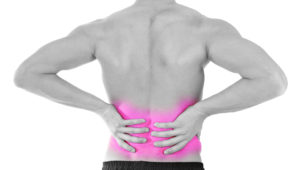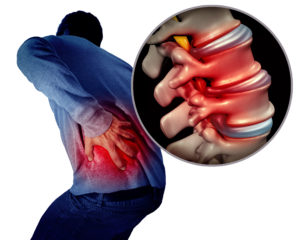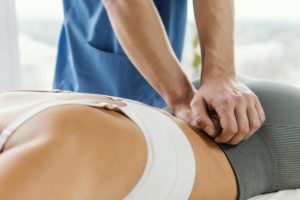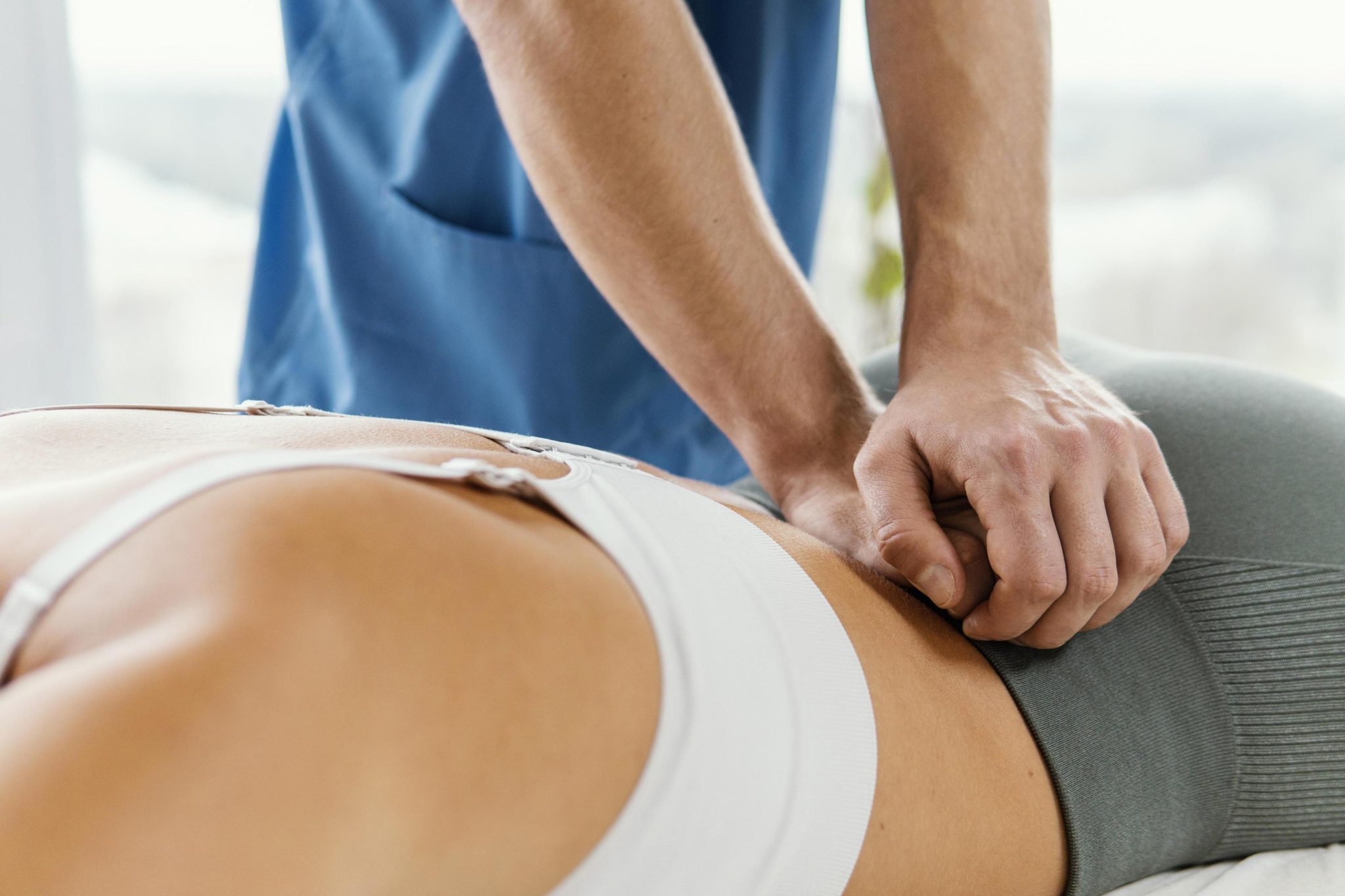Treating Lower Back Spasms with Chiropractic Care
You have most likely had a back spasm at some point in your life, causing an unpleasant experience. Lower back spasms may begin as tingling or numbness or as a sharp, piercing pain when you move incorrectly. On the other hand, the discomfort might be manageable. With a bit of rest, these spasms appear to come and go. However, if the pain is regular, chronic, or severe, it is time to see a doctor. In the article below, Evexia Family Chiropractic dives into how to treat lower back spasms with chiropractic care, dry needling, and more.
What are Lower Back Spasms?
Lower back spasms cause muscle rigidity and may include discomfort, and they frequently occur after an injury. Therefore, it is critical to appreciate the necessity of early therapy since delaying treatment increases the probability of painful muscle knots, which often emerge two weeks after the initial injury.
Muscle spasms are caused by inflammation when a muscle is overstretched or damaged. It starts as a muscle strain and can progress to severe low back pain. Every year, many patients visit the emergency department due to a muscular strain. However, most acute lower back pain bouts are from an injury to the low back muscles and ligaments.
Muscle strains are also known as pulled muscles. When the lower back muscles are strained or damaged, the region around the muscles might become inflamed. Muscle spasms can occur due to inflammation, resulting in significant low back discomfort and difficulties moving. Lower back discomfort caused by a muscle strain is most common after moving a big object, lifting while twisting, or a rapid movement or fall. The discomfort is generally localized, not radiating to the leg. However, the affected area may be sensitive to the touch, and the patient typically feels better while resting.
Fortunately, muscular strains typically recover on their own in a few days or weeks. In addition, lower back muscles have an excellent blood supply, which brings the required nutrients and proteins for recovery.
Back Spasm Symptoms
Back spasms are an uncontrollable contraction or tightening of a muscle caused by discomfort, strain, overuse, weakness, injury, or an underlying ailment. You may suffer a range of symptoms depending on the source of your back spasms. Because the spine and back muscles support the entire body, back spasms frequently affect other sections of the body.
Symptoms of a musculoskeletal system problem may include:
- Pain in the buttocks or hips
- Neck stiffness or pain
- Tense spine
- Shoulder and arm ache
- Numbness, discomfort, or tingling in the buttocks or leg
- Muscle strain or weakness
- Leg sluggishness
You could also encounter neurological symptoms like:
- Arm, leg, shoulder, or buttock numbness, discomfort, or tingling
- Sciatica, a shooting pain that runs down the back of one or both legs
- Headache, especially tension headaches that originate in the back of the skull
If you have any of the below symptoms, you may have a significant medical issue and should seek immediate medical attention:
- On one side of the body, there is numbness or weakness
- Problems with balance and coordination
- Sensation loss in one or more limbs
- Control of the bladder or bowels is lost
- Muscle twitching in the arms or legs
- Fever or nausea accompany the pain
Causes of Low Back Spasms
Muscle spasms are most likely to occur during periods of high physical exercise, particularly if it is more strenuous than usual. This might involve activities like heavy lifting, exercising, or participating in sports. A back spasm is more likely to occur if you are dehydrated, have an electrolyte imbalance, or have an underlying ailment.
Physical stamina
Even if you are physically healthy, you may have gaps in your training that make you susceptible to muscular spasms. These are some examples:
- Dehydration
- Mineral deficiency, particularly calcium and potassium
- Core strength is lacking
- Muscle weakness or tightness in the back
- Tendonitis in the tendons of the legs, particularly the hamstrings
 Back spasms might be caused by your body’s reaction to an underlying ailment. For example, these disorders can cause back muscular weakness or stiffness. Others cause inflammation and discomfort by putting pressure on the spine or nerve bundles.
Back spasms might be caused by your body’s reaction to an underlying ailment. For example, these disorders can cause back muscular weakness or stiffness. Others cause inflammation and discomfort by putting pressure on the spine or nerve bundles.
Lower Back spasms may be caused by a variety of underlying conditions, including:
- Scoliosis or Lordosis (abnormal curvature of the spine)
- Disc herniation or bulge
- Spondylosis and spondylolisthesis
- Spinal arthritis
- Spinal stenosis
Keeping Lower Back Spasms at Bay
The framework of your body is your back. It is the framework to which all other parts of your body are attached. As a result, it is essential to take appropriate care of your back to avoid discomfort and damage. You may be able to avoid lower back spasms by doing the following:
Maintain a healthy weight — Being overweight, even by a few pounds, puts extra strain on your spine and joints. You may lack the necessary muscular power to sustain a healthy spine if you are underweight.
Proper posture – Keeping a good posture relieves stress and strain on the spine and supporting muscles. Consider ergonomic supports or a standing desk if your job requires spending a lot of time at a computer or desk. Excessive sitting or lying down might aggravate muscular spasms.
Exercise regularly — Exercises that strengthen the back and core muscles can help avoid back spasms. Be sure to consult with your provider before beginning a new exercise regimen. Based on your present state, they may have workouts they recommend doing or avoiding to prevent harm.
Lower Back Spasms and Chiropractic Care
While there are alternative choices, many individuals choose to treat their back spasms with a chiropractor. Traditional medical procedures frequently entail the use of powerful prescription pain relievers. Unfortunately, these drugs have the potential to be addictive or habit-forming. Medication, too, just helps the symptoms; it does not address the underlying source of your discomfort. You risk further damage and worsened back pain if you do not treat the underlying reasons for your discomfort.
If you suffer from muscle spasms, you know how inconvenient they can be and how severe ones may be unpleasant. Muscle spasms can occur everywhere on the body, although they are most prevalent in the neck, legs (hamstrings and quadriceps), arms, and back.
Several factors can cause muscle spasms. Excessive or extended exercise is one of the most prevalent. When you exercise too frequently or for too long, your muscles may not have a chance to rest, and muscle spasms might occur. Muscular spasms can also develop due to dehydration, an injury, or some form of muscle damage. Muscle spasms can also signify neuromuscular diseases such as multiple sclerosis (MS).
How Can Evexia Family Chiropractic Help?
Chiropractic care employs a multifaceted approach to pain relief utilizing the body’s innate ability to repair itself. When the spine is out of alignment, muscles across the body overcompensate, resulting in muscular strength imbalances and tendons and ligament tightness. These imbalances can place a lot of strain on the spinal cord and neurons in the back. As a result, the nerves become irritated, producing discomfort and mobility problems. If left untreated, this might result in irreversible nerve damage and function loss.
To restore normal alignment, a chiropractor will employ a variety of techniques. Among these approaches are:
Joint Manipulation for Back Spasms
Chiropractors’ most frequent therapy is joint manipulation. They usually manipulate your spine, but they can also manipulate joints in other parts of your body. Manipulation assists your spine, and your joints regain normal mobility, resulting in less discomfort and fewer muscle spasms.
Soft Tissue Manipulation for Back Spasms
Another typical treatment method for muscular spasms is soft tissue manipulation. Stretching and massage therapy might be used as part of the treatment. These therapies aid in removing fluid, reducing scar tissue, and relaxing muscular spasms.
Dry Needling for Lower Back Spasms
Dry needling is a common treatment method for a wide range of medical issues including lower back spasms. Dry needling targets specific areas in the body referred to as trigger points using thin filiform needles to penetrate the skin. Dry needling significantly reduces the intensity of the lower back pain along with other muscle discomforts and soreness. For Lee’s Summit dry needling services, schedule an appointment with Evexia Family Chiropractic today!
Exercise
Chiropractors will frequently offer strength training activities and stretching exercises for you to undertake in between appointments. However, it is vital to perform daily exercises to supplement the therapies and encourage speedier healing.
Additional Therapies for Lower Back Spasms
A chiropractor may also employ complementary treatments to alleviate muscle spasms. Hot and cold therapies, electrical stimulation of the afflicted muscle, and ultrasounds are examples of such treatments. These treatments significantly improve circulation to the muscles while also preventing muscular edema and scarring. In addition, associated therapies frequently relieve pain and serve as a method of preventing additional injury and recurrence of harm. The ultimate aim, of course, is to stop muscular spasms.
Wrapping Up Treating Lower Back Spasms
Don’t let lower back pain and the spasms keep you from living a healthy, active life. Schedule an appointment with Evexia Family Chiropractic today to start treating lower back spasms and to reduce other pain and soreness as well. We are the Lee’s Summit chiropractic experts and are passionate about your entire health and well-being. Contact us today!

